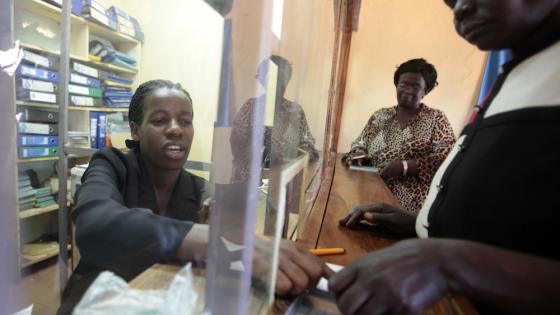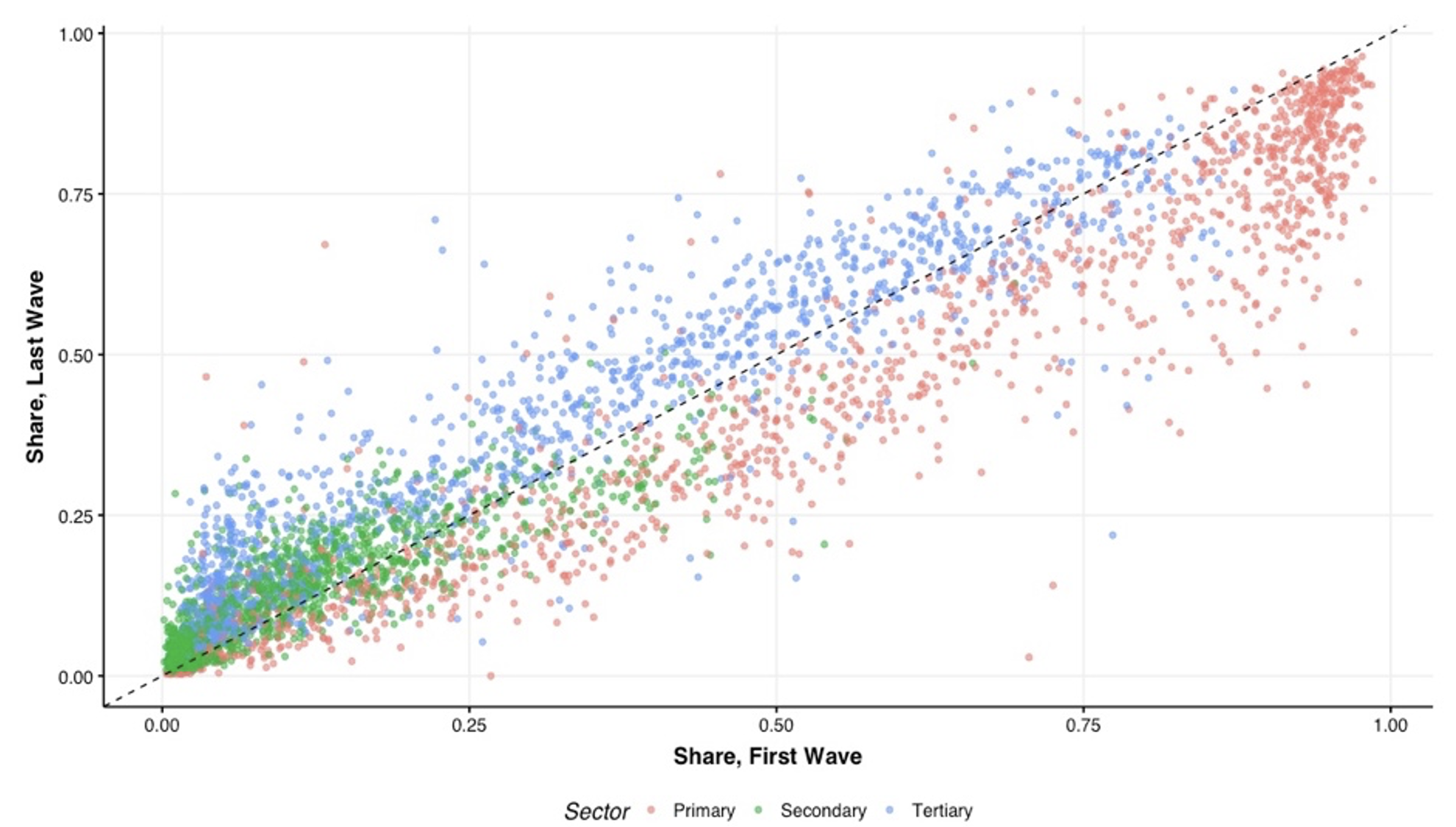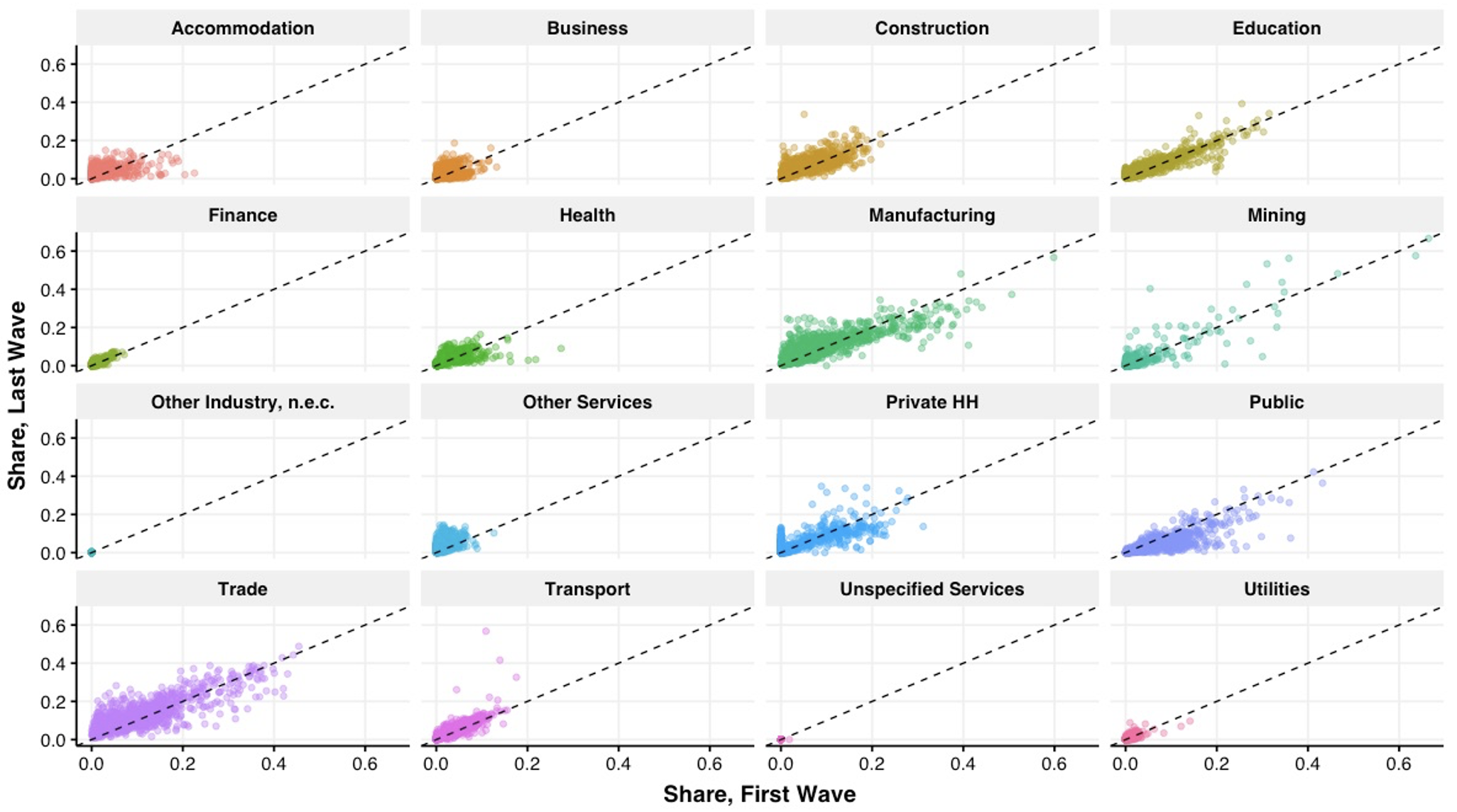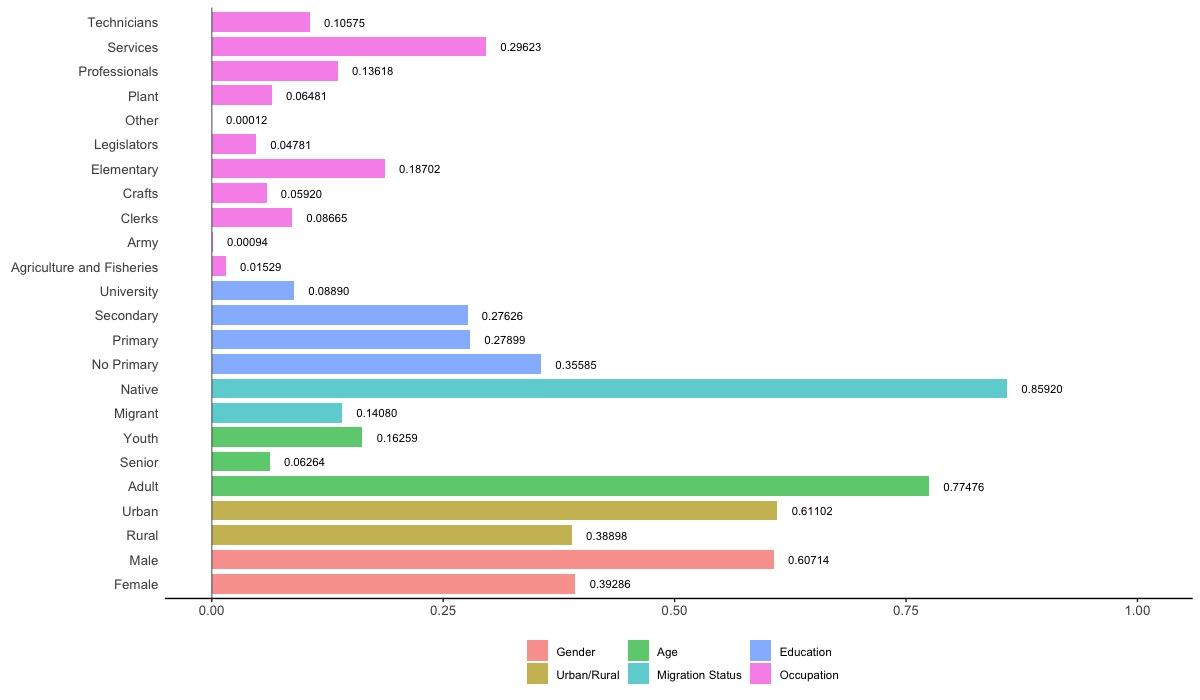A central feature of the successful structural transformation of most economies in the 20th century involved the shifting of workers from agriculture to manufacturing (Herrendorf et al. 2014). This pattern of economic growth and development may be less applicable to lower-income countries today than it was in the past. An important stylised fact in this regard is that low-income developing countries are moving into services earlier and at a faster rate than East Asian economies did in the 1970s and 1980s. The associated ‘premature deindustrialisation’ (Rodrik 2016) is a source of concern insofar as it implies that low-income countries today cannot rely on an expanding manufacturing sector to create employment opportunities for relatively unskilled workers, drive economic growth, and increase per capita incomes. Other observers argue that services-led sectoral transformation can drive sustainable development prospects (Newfarmer et al. 2018, Hsieh and Rossi-Hansberg 2021, Nayyar et al. 2021). Research shows that the services content of manufacturing value added has been rising (Lodefalk 2015), heightening the salience of services trade policies for overall export performance and manufacturing productivity (Beverelli et al. 2017, Hoekman and Shepherd 2017), while global value chains increasingly span services as well as agriculture and manufactures (Nano and Stolzenberg 2022). These findings underscore the need to understand the process of servicification and the effects of services policies.
In a recent paper (Baccini et al. 2021), we contribute to the emerging literature that analyses structural transformation in low-income economies using micro data as opposed to a focus on trade, global value chains, and broad sectoral shifts and aggregate indicators of output and employment at the country level. In this column, we present new data on the composition of jobs in services at the sub-national level in a sample of 13 African countries, describe how this has changed over time, and explain how employment in services correlates with indicators of economic development commonly used in the literature. A companion project webpage1 provides country specific graphs and maps plotting changes in sectoral employment and occupational dynamics over time.
Individual-level data
We use the IPUMS International Database published by the Minnesota Population Center, extracting data for all African countries for which at least two censuses are available and that include information on the industry employing an individual. The resulting dataset spans 56 million individuals, covering 1,546 administrative units in the 13 African countries2 for either two or three census waves during the period 1982–2013. The sample is representative of the Africa region, covering low- and middle-income countries, resource-dependent and more diversified economies, and a mix of landlocked nations and countries with sea borders.
Structural transformation towards services: Subnational-level data
The shift towards services that is generally found at the country level is evident in our sample of subnational units in Africa. Figure 1 plots decadal changes in employment shares across the primary, secondary, and tertiary sectors. Independent of per capita income level and endowments, across all subnational units, the share of agriculture in total employment declines while that of services increases. Across all the administrative units in our sample of countries, there is a decline in the total share of employment in agriculture of six percentage points, offset by an equivalent increase in the share of employment in services sectors. The share of the secondary sector shows a heterogenous pattern, often increasing in geographic units with a low initial base while frequently declining in administrative units with initially high shares of secondary sector employment.
Figure 1 Change in sectoral employment shares at the sub-national level
Note: Each dot represents an administrative unit that is observed over two successive waves of the census.
Source: Authors’ elaboration on IPUMS.
Figure 2 reports similar information at the industry level (at the 2-digit level of the ISIC rev. 3). A few industries within services appear to drive the trends observed in Figure 1, notably trade (distribution services) and construction. Business, finance, and other services also increase but from a very small base. Country-specific data reveal interesting heterogeneity across sectors over time (e.g. a visible decline in public sector employment in Botswana, Tanzania, and South Africa).
Figure 2 Structural transformation at the sub-national level: Sector specific data
Note: Each dot represents an administrative unit, observed over two successive waves of the census. Agricultural sector is excluded to allow better visualisation of smaller industries (given that all industries share the same values in the Y-axis).
Source: Authors’ elaboration using IPUMS.
Who works in services?
While services are a major source of employment in Africa, surprisingly little is known about their characteristics and their composition. In our paper, we decompose the characteristics of workers according to the following dimensions: gender, urban/rural residence, age cohorts, migration status, education, and occupation.3 Figure 3 summarises the average characteristics of workers in services across all countries included in our sample. Compared to manufacturing, service workers are on average more educated, engage in higher skilled occupations, and are more likely to be women – 40% of employees are women, twice as many as in manufacturing. Some of the more skilled occupations are concentrated in services, including education. Overall, 8.9% of those employed in services hold a university degree (2.8% in manufacturing) and 27.6% have a secondary school education (15.1% in manufacturing).
Figure 3 Characteristics of workers in the services
Source: Authors’ elaboration on IPUMS.
Services and economic development
Exploratory analysis of the relationship between services and economic development, using per capita nightlight luminosity as a proxy, reveals substantial heterogeneity. We distinguish between high- and low-skill service sectors, sorting service industries by the intensity of their use of workers who have a university degree and are engaged in more complex occupations. Sectors that use these categories of workers more intensively than the average observed in manufacturing are classified as high skill. Disaggregating the tertiary sector by skill intensity reveals that only higher-skilled services are strongly associated with development. We also show that the strong positive association between high-skill service sectors and development is mediated by geography, institutions, and technology. Greater incidence of malaria, the presence of a mining facility, and below average mobile phone coverage in an administrative unit reduces or undoes the significance of the positive association.
Jobs and productivity in the longer term
In line with Lagakos and Shu (2021), our analysis demonstrates how exploiting the potential of microdata can help account for the high degree of heterogeneity across services activities as a function of observable characteristics of workers. An important open question suggested by our findings concerns a potential trade-off in the capacity of different types of services to increase productivity and employment. While lower-skill service activities may have less potential to support growth, they do generate jobs and thus income. Recent research shows that firms in certain services can scale up and improve productivity performance by using new technologies (Davies et al. 2022, Hsieh and Ross-Hansberg 2021), but more evidence is needed from African firms to understand the longer-term opportunities and implications of structural transformation towards services.
Authors’ note: This paper on which this column is based was supported by the International Growth Center (Grant XXX-20086).
References
Baccini, L, M Fiorini, B Hoekman and M Sanfilippo (2021), “Services, Jobs and Economic Development in Africa”, CEPR Discussion Paper 16924 (forthcoming in World Bank Research Observer).
Beverelli, C, M Fiorini and B Hoekman (2017), “Services Trade Restrictiveness and Manufacturing Productivity: The Role of Institutions”, Journal of International Economics 104(1): 166–82.
Beverelli, C, M Fiorini and B Hoekman (2015) “Services Trade Restrictiveness and Manufacturing Productivity: The Role of Institutions”, VoxEU.org, 16 October.
Crozet M and E Milet (2015), “The future of manufacturing lies in services”, VoxEU.org, 15 December.
Davies, E, M Hallward-Driemeier and G Nayyar (2022), “For services firms, small can be beautiful”, VoxEU.org, 12 January.
Herrendorf, B, R Rogerson and A Valentinyi (2014), “Growth and Structural Transformation”, Handbook of Economic Growth, Vol. 2. Amsterdam: Elsevier, 855–941.
Hoekman, B and B Shepherd (2017), “Services Productivity, Trade Policy and Manufacturing Exports”, The World Economy 40(3): 499–516.
Hsieh, C and E Rossi-Hansberg (2021), “The Industrial Revolution in Services”, Center for Economic Studies Working Paper CES-21-34.
Lagakos, D and M Shu (2021), “The Role of Micro Data in Understanding Structural Transformation”, STEG Pathfinding Paper.
Lodefalk, M (2015), “Tear down the trade-policy silos! Or how the servicification of manufacturing makes divides in trade policymaking irrelevant”, VoxEU.org, 16 January.
Nano, E and V Stolzenberg (2022), “Global services value chains: A new path to development”, VoxEU.org, 5 January.
Nayyar, G, M Hallward-Driemeier and E Davies (2021), At Your Service?: The Promise of Services-Led Development, Washington DC: World Bank.
Newfarmer, R, J Page and F Tarp, eds. (2018), Industries without Smokestacks: African Industrialization Revisited, Oxford University Press.
Rodrik, D (2016), “Premature deindustrialization”, Journal of Economic Growth 21(1): 1–33.
Rodrik, D (2015), “Premature deindustrialisation in the developing world”, VoxEU.org, 12 February.
Endnotes
1 https://globalgovernanceprogramme.eui.eu/services-and-economic-development-in-africa
2 The sample includes Benin, Botswana, Egypt, Ghana, Malawi, Mali, Mauritius, Morocco, Mozambique, Rwanda, South Africa, Tanzania, and Zambia.
3 Occupations are classified at the one-digit level of the International Standard Classification of Occupations (ISCO) 1988 scheme.










